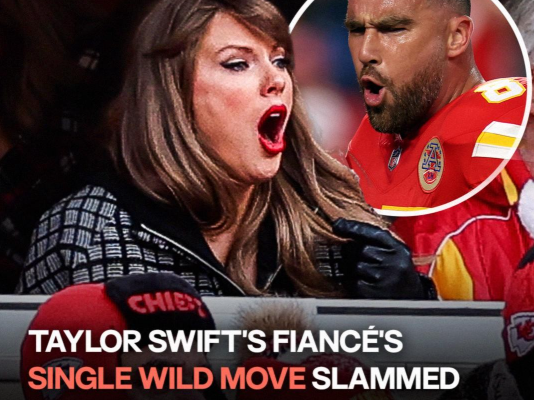
The Incident
During the pre-game sequence of a recent Kansas City Chiefs game, a sideline video of tight end Travis Kelce surfaced showing him seemingly bouncing on the sidelines, hand over his heart, but also moving his feet, swaying and kicking his legs rather than standing still—a contrast to the more composed posture of teammate Patrick Mahomes.
This clip went viral on TikTok and other social channels, prompting a wave of reactions: some light-hearted and humorous, others strongly critical.
The Backlash and Support
Critics argued that Kelce’s behavior came off as disrespectful or out of step with the solemnity often associated with the playing of the The Star‑Spangled Banner before sporting events. One major media outlet claimed fans accused him of “mocking America.”
At the same time, some defended him, pointing out that his animated manner might simply reflect his personality and pre-game energy rather than any political statement. As one fan put it:
“Travis has to be hyped up to grab the ball and make the play… totally makes sense and there’s nothing weird about it.”
Another angle: Kelce has once publicly expressed strong feelings about the anthem—he revealed in a podcast that he rewatched a particular Super Bowl anthem performance “on a sad day” and said “I cried.”
Context: Why It Matters
Understanding the broader landscape helps: for years, the national anthem has been a flash-point in sporting events in the U.S. because of protests and debates around patriotism, race, and player conduct.
In that context, even what might seem like subtle differences in posture or energy during the anthem can become magnified by social media. Kelce’s high profile—both as a football star and a public figure via his relationship with Taylor Swift—makes his actions all the more visible.
What Kelce’s Behavior Suggests
A few possible interpretations:
-
Pre-game adrenaline: Kelce is known for being energetic, vocal and expressive. His bouncing motion might simply reflect getting ready for the game rather than any intentional statement.
-
Personality expression: Some fans noted that his style (“human exclamation point,” as Swift once described him) is about bringing a heightened vibe everywhere.
-
Perception risk in national symbolism: Even if unintentional, in the highly symbolic moment of the anthem, deviation from a widely accepted norm (standing still, reverently) can trigger interpretation as disrespectful—especially among viewers sensitive to traditional displays of patriotism.
Impact on Kelce and the Chiefs
-
Media attention: The incident drew social media commentary and headlines, shifting some focus from on-field performance to off-field optics.
-
Team culture perceptions: While teammates including Mahomes appear supportive, critics might use such behavior to question commitment or seriousness, even if unjustly.
-
Fan sentiment: Among the wide Chiefs and NFL fanbase, reactions were mixed—some amused, some annoyed. These perceptions matter because they influence public image, endorsement potential, and the player-fan relationship.
Broader Themes & Implications
-
Symbolism vs. spontaneity: What’s at stake is that moments like the national anthem carry deep cultural meaning. When athletes act outside expected norms (e.g., standing still, hand over heart, minimal movement), it can be taken as a statement—even if that wasn’t the intent.
-
Athlete persona vs. institutional expectations: Kelce has cultivated a persona of exuberance, charisma and showmanship. That sometimes clashes with institutional expectations of solemnity and uniformity in ritual moments.
-
Social media amplification: With video clips and memes spreading instantly, small gestures become large conversations. The “viral” label means there’s no escape from scrutiny.
-
Reflection of shifting norms: The anthem moment has changed over time—what once was relatively unexamined is now under scrutiny for each gesture or posture, reflecting evolving cultural expectations in sports and society.
What’s Next for Kelce
-
Public comment: It remains to be seen whether Kelce will publicly respond to the criticism or address the moment—either to clarify intention or reaffirm respect for the anthem.
-
On-field performance: Ultimately, performance may overshadow the anthem moment if Kelce continues to deliver at a high level. Strong play often mitigates ancillary controversies.
-
Brand and endorsements: Given his visibility, brands may weigh how such incidents affect his marketability—though his large fanbase and persona may offset any negatives.
-
Team response: The Chiefs organization may review whether they need to manage pre-game protocols differently (e.g., limiting sideline movement during anthem) to avoid distraction.
Final Thoughts
The Kelce national anthem incident is less about a single act and more about how modern sports culture interprets behavior in symbolic moments. Travis Kelce’s animated stance during the anthem lit up social media not simply because he moved—but because movement in that moment is loaded with meaning.
For Kelce, how he handles the aftermath may matter nearly as much as what he did. If he leans into his authentic self—while showing respect for tradition—he’ll likely weather the storm with minimal long-term impact. If he ignores the optics, however, it gives critics material and risks becoming a recurring narrative rather than a footnote.

